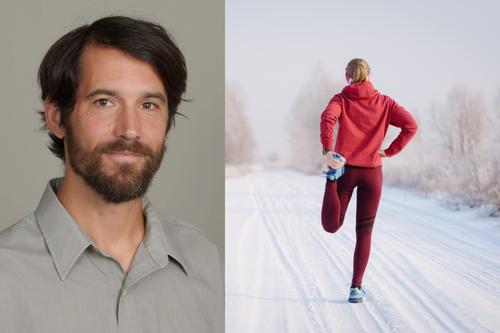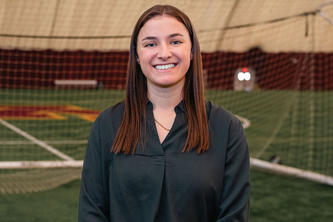
As temperatures drop in the winter months, many outdoor activities move indoors. However, runners still gear up and train for races year round.
Christopher Lundstrom, a lecturer in the School of Kinesiology, shares tips on to approach running in cold temperatures.
Q: Is it safe to run in cold weather?
Dr. Lundstrom: For the vast majority of runners, heading out in the cold is quite safe when done with proper clothing. The main concerns for the typical runner are hypothermia and frostbite. Hypothermia occurs when the body temperature drops, which can happen in cold temperatures as well as milder temps when it is wet, and/or windy. The good news is that running and other forms of exercise naturally produce heat, and allow you to maintain your body temperature wearing lighter clothing than you would be able to get away with if you were not exercising.
Frostbite occurs when the skin freezes, typically due to leaving skin exposed in very cold weather. There is also an increase in cardiovascular demand in cold temperatures, which is potentially concerning for anyone with heart issues. Similarly, those with asthma or other pulmonary issues may need to consult with a medical professional prior to exercise. But the good news is that if you keep your core temperature up and protect your skin, most people can comfortably and safely run in cold weather.
Q: How should runners prepare for low temperatures?
Dr. Lundstrom: The first step is to check the weather conditions, including temperature, wind, and precipitation. Understanding what conditions you are likely to encounter during your run allows you to dress appropriately and potentially choose an optimal route. Dressing in layers is a basic, yet very important suggestion for cold weather exercise. A breathable base layer and a weather-resistant outer layer are a good start. Gloves and/or mittens, and a warm hat that covers your ears will keep those extremities protected from the elements. On particularly cold and/or windy days, a skin barrier product can provide protection for any skin that remains exposed (cheeks, nose, etc), though a winter face mask is also a good option.
In terms of route selection, if it is icy, avoid high traffic areas, or choose a route where the surface has been cleared. If it is windy, you may want to run a course that goes out into the wind, and then finishes with the wind at your back. This will help you avoid having to run into a wind when you have already broken a thorough sweat.
Q: Do runners need to adjust warm ups and cool downs in the winter season?
Dr. Lundstrom: The main thing to pay attention to when structuring your workout is avoiding extended periods of standing around out in the elements, whether that’s before, after, or during your run. If you typically do some mobility or flexibility exercise before, or any core or other auxiliary exercises after your run, do all of that indoors if possible. If you don’t have that option, wear extra layers for your warmup and toss whatever you don’t need aside immediately before you start your run. Whatever you plan to do after your run, get into dry clothes as soon as you can. Just a few minutes of standing around in the cold in sweaty clothes can cause your body temperature to plummet. If you are doing some type of an interval workout or other workout that includes breaks during the run, be sure to keep moving enough to keep your body temperature up.
Q: How can someone avoid slipping or falling? Any tips for bouncing back from an injury?
Dr. Lundstrom: When the footing is icy or slippery, use caution in terms of where you are stepping, and slow down and shorten your stride as needed, especially if you are trying to change speed or direction. Likewise, be cautious around hills. You have to push a little harder to go up, which can lead to more slipping, and going down hills tends to cause an increase in speed, which makes you more likely to fall. If you do a lot of running on ice and snow, ice traction cleats are a worthwhile investment. These can be slid over your running shoes for the runs when you need them, and easily removed when the roads are clear. If you do strain a muscle due to slipping, it’s better to take a few days off or cross train right away to allow it to heal, rather than continuing to run on icy roads that may exacerbate your strain.
Q: What additional resources might be helpful to consider?
Dr. Lundstrom: Refer to current weather conditions, taking into account both temperature and windchill. Don’t forget to account for your own speed of movement, which adds to the effective wind speed. In other words, if you are running 6 mph into a 10 mph wind, the effect is the same as a 16 mph wind standing still. Check out the ACSM’s statement on cold weather exercise, which has a great chart showing risks at particular wind chills. It’s also a good idea to run with a group or a friend in all conditions, but especially when the weather is less than ideal. Here in the School of Kinesiology, we offer classes such as Beginning Running or, for the bold and daring, Marathon Training. These courses provide a supervised, group running experience.
Christopher Lundstrom is a lecturer in the School of Kinesiology. His research interests center on endurance exercise training and performance. Specifically, he is interested in running economy, aerobic capacity, metabolic substrate utilization, and heart rate variability. He has been teaching courses in the areas of sports science, training theory, coaching, and physical education at the University of Minnesota since 2006.
-30-
About the College of Education and Human Development
The University of Minnesota College of Education and Human Development (CEHD) strives to teach, advance research and engage with the community to increase opportunities for all individuals. As the third largest college on the Twin Cities campus, CEHD research and specialties focus on a range of challenges, including: educational equity, teaching and learning innovations, children’s mental health and development, family resilience, and healthy aging. Learn more at cehd.umn.edu.
About “Talking...with U of M”
“Talking...with U of M” is a resource whereby University of Minnesota faculty answer questions on current and other topics of general interest. Feel free to republish this content. If you would like to schedule an interview with the faculty member or have topics you’d like the University of Minnesota to explore for future “Talking...with U of M,” please contact University Public Relations at [email protected].
- Categories:
- Sports and Recreation




